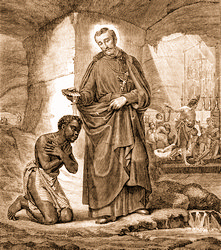Lives of the Saints
Our Models and Protectors
Spiritual Bouquet:
September 9

Saint Peter Claver
Jesuit Missionary
(1580-1654)
If anyone wonders what exactly it is that constitutes a Saint, he has only to read the life of Saint Peter Claver, in whom the superhuman life of grace acted so visibly as to create a person who seemed more than a man. This holy Jesuit, born in Spain in 1580, was during his novitiate a disciple of Saint Alphonsus Rodriguez, the holy porter of Majorca, a humble lay-brother endowed with the highest gifts of contemplation and prophecy. The two would eventually be canonized together by Pope Leo XIII in 1888, thus cementing the perfect union which began on earth and certainly continues in heaven. Saint Alphonsus, when he saw the novice for the first time, was inspired to kiss his feet; and the novice embraced his spiritual father with a tenderness which would increase with time. A little later, the preceptor learned from a vision that this novice was destined to save a multitude of souls in the New World; he said to Peter: How many peoples go astray for lack of ministers! The fatigue of going to seek them out is dreaded, but not the danger and crime which it is to abandon them! Eventually Saint Alphonsus revealed his divinely revealed calling to him, to inspire in him an active desire to respond to the explicit Will of God.
After eight years of study and apostolic preparation in Spain, Saint Peter asked to go to the Jesuit missions of the Western Indies, and was sent to Carthagena in Colombia, South America, when he was thirty years old. He was assigned to accompany an elderly priest who had undertaken a ministry of service to the poor Africans brought to be sold in the market of that city. These poor strangers spoke several languages but shared a common misery, which Saint Peter soon saw clearly. When the holds of the boats were opened, all one beheld was a confused mass of men, women, children and old men, sick persons mingled with healthy ones, and often, alas! living beings next to cadavers, for the crossing made victims. The elderly forerunner of Peter, when about to retire, asked that the objects of his care be definitively confided to Peter Claver, a petition willingly granted.
Thus began forty-four years of unceasing dedication to their spiritual and material betterment by Saint Peter. He watched for the arrival of the slave ships, which brought from ten to twelve thousand souls each year, and never failed to be the first to go aboard, accompanied by his interpreters and carrying the provisions he had been able to beg. He greeted the living, arranged for the burial of the dead and the transport of the sick to hospitals. Having won their sympathy, he went to them regularly with his interpreters and taught them, during several hours' time, the elements of doctrine, aided by pictures. Before he died, he had baptized 400,000. He put around the necks of each newly baptized child of God, a medal which would thereafter distinguish the Christians from the yet untaught.
Though this was his principal industry, he also spent many days in the nearby lazaretto — a refuge for lepers — and in the hospitals of the region. No infirmity repelled him; the Brother who accompanied him had several times a day to clean his cloak, on which he would lay the sick while he arranged their poor beds. It never ceased to emit a heavenly fragrance. He slept only two or three hours at night, and ate almost nothing. The poor were his beloved children and he their beloved father, whose visits were anxiously awaited and were always too short. Those who resisted him did not do so indefinitely; one man insulted him for twenty-two years, but at the end of that time fell on his knees and begged his pardon. The vision of his charity is certainly reserved for heaven; his biographers scarcely find words adequate to describe his heroic life. Pope Pius IX, who beatified Saint Peter in 1851, commented that never had he read a life of a Saint which so moved him.
After Saint Peter contracted the plague in his declining years, he was left infirm and partially paralyzed. He then had himself tied to a donkey and in that way went about begging and distributing provisions. He had a rude servant who often neglected him and mistreated him, but when his brethren offered him another, asked to be allowed to keep that one, who treated him far better than he deserved. Two years after his death at the age of seventy-four, his body was found intact, despite the humidity of the burial site and the live caustic covering it. Miracles proliferated there and elsewhere by the invocation of his name. A large church was built in Carthagena in his honor, and he became the second patron of his adopted land, Colombia.
Vie abrégée de Saint Pierre Claver, Jésuite, l'Apôtre de Carthagène, by a priest of the diocese of Montreal, 1925